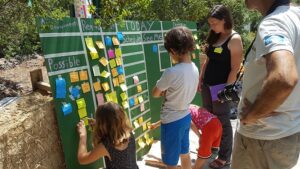What is a Kanban?
Kanban means sign in Japanese.
Kanban boards use visual cues to prompt the action needed to keep a process flowing.
In agile learning we use kanbans to make our intentions and the monitoring of our work visible.
They take many different forms. Here are two examples:
Offers / Requests / Program Kanban
Learning offers and requests are presented in this Kanban. All members of the learning community can contribute. These are assigned, combined, staffed and scheduled at the scheduling meeting (setting the day, the week, the term, the year, etc.)



Community Mastery Kanban
The Community Mastery Kanban is a tool that builds community culture. It is divided into four columns:
- Awareness (community problems that need to be solved)
- Implementation (the determined action for each problem)
- Practice (changes applied)
- Mastery (changes are established, and an aspect of our culture are created)
Two guidelines for Kanbans are: visualise your work and limit the work in progress. Visualising our work paves the way for the realization of our intentions. It helps us stay focused and take on our responsibilities. By limiting work in progress we can get deeply involved in what we do. Using Kanbans we learn to be efficient in how we use our time and setting our priorities, in order to make conscious choices about what to engage in.
A Kanban can be divided into columns: To be Done, Doing, Done and using sticky notes the board is filled with ideas, intentions and work in progress.
The To Be Done column contains things we want to do, explore, create. On a daily basis, the list of possibilities is prioritised, visualised, evaluated, and finally reaches the Done column.
Kanbans are agile tools that can be customised depending on what works best for the users.